| This was my first attempt at settingup a mountain topping station. A card table in the back of a pickup truck. A portable tower, Generator, cables, wires, key, mikes, etc. It ended up that I spent more time setting it up and tearing it down that I was too exhausted to operate. The generator was a constant problem getting it to run right even when it was tested numerous times a home before the treak to the mountain. So, after this disasterous start. I started "engineering" for success. The following pictures and commentary explain the evolution that I went through to "get it right". |
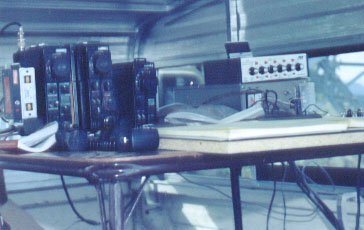 |
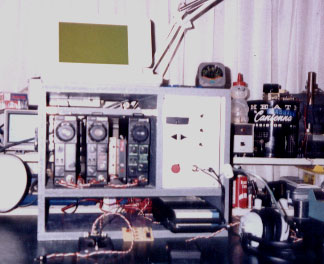 |
After the experience of trying to mountain top with a "pile" of equipment cobbled together the night before the contest, hauled up to the mountain and operated. I started building "contest specific" radio setup. I built the station box shown here. It contains the three ICOM book radios, a tape recorder for a voice CQ message, Antenna rotator controls, Microphone switching controls, a boom headset and foot switch, a small dos computer for logging. All the power, antenna and rotator cables plug into the back. Everything is prewired so it can be plugged together quickly and easily. This was a "dream setup" to operate in a VHF/UHF contest. It was very quick to setup and tear down and I was 6th in the Nation QRP Portable twice with this setup. I think I was now on the right track for making a winning station that was easy to use. |
| Here I am operating one of the VHF/UHF Sweepstakes from a "concrete mountain" in the Los Angeles, California area. This whole station could be setup in about an hour and a half and be ready to operate. I made an operating table top that clipped onto the back of my car and I didn't place nationally on this contest but I was the first place QRP Portable station in California. The Tripod supported the antenna and the deep cycle RV battery was the counterweight for the antenna. I put the 6 meter 3 element beam on top followed by the 2meter beam and the 432Mhs beam. This was to provide the lowest frequency the most height above ground. The 6 meter beam is 16 feet off the ground. By evaluating the operations and score, More improvements were needed if I was going to score higher than 6th in the nation with this setup, which I did twice. |
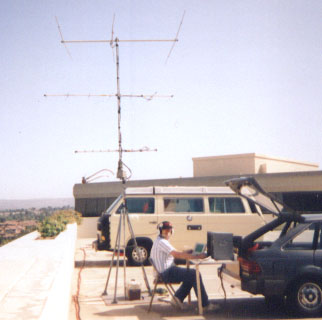 |
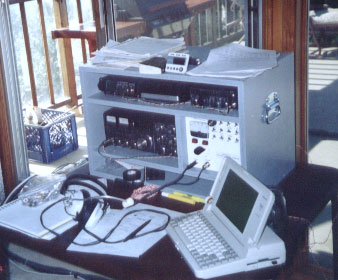 |
This was my next "Contest Radio Box" for the VHF/UHF contests. It used a Yaesu FT-726 Satellite Radio Transceiver which put out 10 watts on 6 meters, 2meters and 432 Mhz. I added a 220 FM 10 watt transceiver a 2 meter all mode rig that was driving a Down East Microwave 1296 transverter with a preamp and 3 watt PA amplifier. It used the same tape recorder with a 20 second endless tape in it to provide the voice CQ. I also had to add a delayed keying system to provide all the switching for the 1296 transverter. The switch panel on the right provided the microphone and keyline switching and power control for the radios and preamps. I still used the old laptop for logging and boom mike from the first unit. I did have to add another deep cycle RV battery for the extra power requirements and a small 12V battery in series for some 24 volt relays. I was 4th in the nation twice with this setup. I operated from a friends house on the side of Palos Verde Mountain in Lomita, California. |
|
This is a picture of how my Antenna System changed with the
new radio box. The top antenna was still the 6 meter 3 element
beam. Next the 2 meter beam and 432 at the bottom. The cross
arm holds the 220 and 146 Mhz FM vertical beams and the horizontal
and vertical 1296 Mhz beams. There was also a 440 Mhz vertical
FM beam on the main pole just above the 432 Mhz horizontal beam. The flat plate in the middle is the 1296 transverter. By mounting it on the antenna eliminated the need for a long expensive coax to get the 1296 transmitter power to the antenna. I had to later put the 1296Mhz transverter in a waterproof plastic box to protect it from the morning dew or rain. Since this setup was only up for the weekend of the contest a lot of extensive waterproofing was not necessary. |
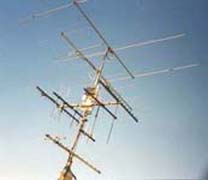 |
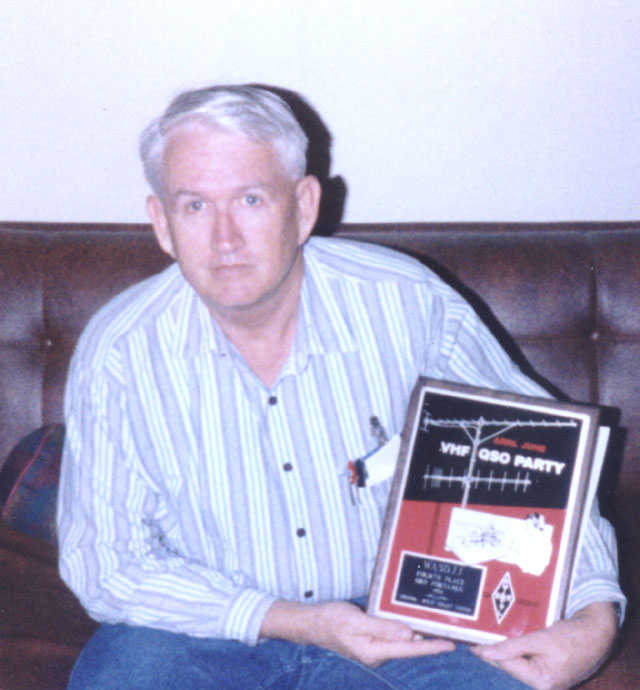 |
So, This is the reward for all the study, work and preparation. The ARRL 4th place QRP Portable Plaque that I won in the December 1994 VHF/UHF contest. I was told by a lot of west coast VHF'ers that it couldn't be done. Since I won mine a number of others have won from out there and broke the strangle hold that the East Coast VHf'ers have had on these contests. I have operated from my new home in New Mexico but now am just getting too old to drag all that stuff up a 9000 foot mountain top. But don't count me out. I now have a really neat Yaesu FT-817 all mode qrp radio and with the right antennas, coax, batteries, and other nice small solid state devices. I just may be back to give it another go from some neat mountain top in New Mexico. |